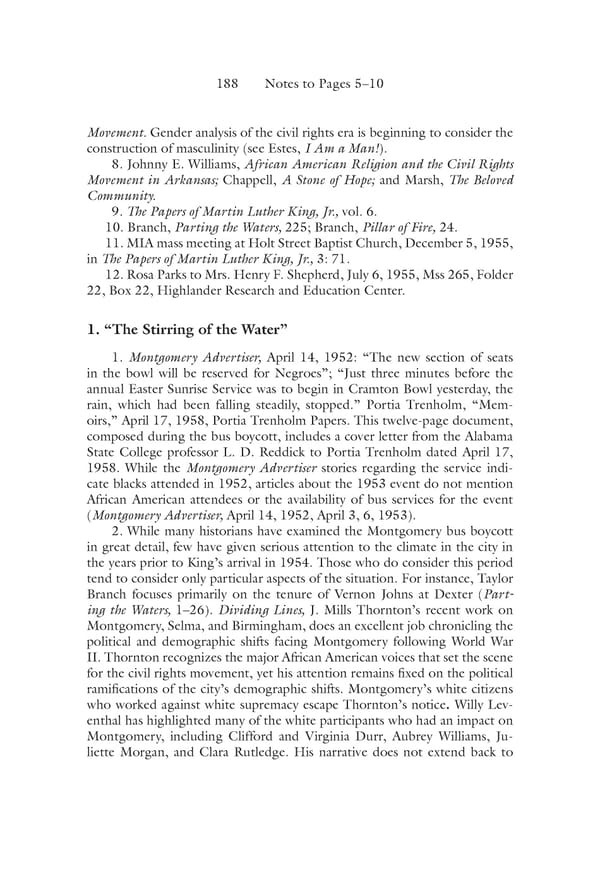188 Notes to Pages 5–10 Movement. Gender analysis of the civil rights era is beginning to consider the construction of masculinity (see Estes, I Am a Man!). 8. Johnny E. Williams, African American Religion and the Civil Rights Movement in Arkansas; Chappell, A Stone of Hope; and Marsh, The Beloved Community. 9. The Papers of Martin Luther King, Jr., vol. 6. 10. Branch, Parting the Waters, 225; Branch, Pillar of Fire, 24. 11. MIA mass meeting at Holt Street Baptist Church, December 5, 1955, in The Papers of Martin Luther King, Jr., 3: 71. 12. Rosa Parks to Mrs. Henry F. Shepherd, July 6, 1955, Mss 265, Folder 22, Box 22, Highlander Research and Education Center. 1. “The Stirring of the Water” 1. Montgomery Advertiser, April 14, 1952: “The new section of seats in the bowl will be reserved for Negroes”; “Just three minutes before the annual Easter Sunrise Service was to begin in Cramton Bowl yesterday, the rain, which had been falling steadily, stopped.” Portia Trenholm, “Mem- oirs,” April 17, 1958, Portia Trenholm Papers. This twelve-page document, composed during the bus boycott, includes a cover letter from the Alabama State College professor L. D. Reddick to Portia Trenholm dated April 17, 1958. While the Montgomery Advertiser stories regarding the service indi- cate blacks attended in 1952, articles about the 1953 event do not mention African American attendees or the availability of bus services for the event (Montgomery Advertiser, April 14, 1952, April 3, 6, 1953). 2. While many historians have examined the Montgomery bus boycott in great detail, few have given serious attention to the climate in the city in the years prior to King’s arrival in 1954. Those who do consider this period tend to consider only particular aspects of the situation. For instance, Taylor Branch focuses primarily on the tenure of Vernon Johns at Dexter (Part- ing the Waters, 1–26). Dividing Lines, J. Mills Thornton’s recent work on Montgomery, Selma, and Birmingham, does an excellent job chronicling the political and demographic shifts facing Montgomery following World War II. Thornton recognizes the major African American voices that set the scene for the civil rights movement, yet his attention remains fixed on the political ramifications of the city’s demographic shifts. Montgomery’s white citizens who worked against white supremacy escape Thornton’s notice. Willy Lev- enthal has highlighted many of the white participants who had an impact on Montgomery, including Clifford and Virginia Durr, Aubrey Williams, Ju- liette Morgan, and Clara Rutledge. His narrative does not extend back to
 Becoming King: Martin Luther King Jr. Page 208 Page 210
Becoming King: Martin Luther King Jr. Page 208 Page 210